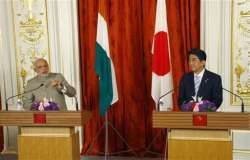Japan wooing India to contain China, says Chinese daily
Beijing: Japanese Prime Minister Shinzo Abe is wooing India to contain China on its eastern and western fronts, a prominent Chinese commentator stated Friday following Indian Prime Minister Narendra Modi's five-day visit to Japan that

Beijing: Japanese Prime Minister Shinzo Abe is wooing India to contain China on its eastern and western fronts, a prominent Chinese commentator stated Friday following Indian Prime Minister Narendra Modi's five-day visit to Japan that concluded Wednesday.
“Abe wants to build a close security partnership with India so as to contain China on both its eastern and western fronts. It also wants support in its territorial dispute with China,” the China Daily said in an opinion piece written by Cai Hong, the newspaper's Tokyo bureau chief, headlined “Abe woos Modi in a bid to contain China”.
“Abe, who has sought to build security options for Japan beyond the current US-centric framework, has argued that his country's ties with India hold 'the greatest potential of any bilateral relationship anywhere in the world',” it stated.
It said, on his part, Modi was “seeking to strengthen economic and strategic cooperation with partners in East and Southeast Asia as part of his government's 'Look East' strategy”.
Stating that comparisons are often made between Modi and Abe, it pointed out that while Modi is the first Indian prime minister to be born after India's independence, Abe is the first Japanese prime minister to be born after World War II.
“Modi and Abe are both assertive nationalists who came to power on platforms pledging economic revival and bolstering their countries' defences and strategic partnerships with like-minded states,” the opinion piece stated.
Stating that Modi has forged a personal rapport with Abe, it pointed out that “when Abe returned to power, Modi broke diplomatic protocol and called to congratulate him despite the fact that he was chief minister of India's western state of Gujarat rather than a head of state”.
It said that this relation between the two leaders will also help boost Japan-India defence equipment and technology cooperation.
“Japan is mulling over exporting its maritime self-defense force's US-2 amphibious search-and-rescue aircraft to India. The plane, which has the capability to land on rough seas with waves of up to three metres and is suitable for long-range civilian and military applications, costs an estimated $110 million per unit.”
It said that while the Indian Navy was keen to acquire this expensive aircraft, Japan was planning to give low interest loans to help India acquire it.
“The sale of the US-2 amphibious aircraft will open up Japan's defense industry for additional contracts with foreign partners and stimulate Japan's defense industry,” the Chinese daily stated.
It also mentioned that the two countries were also negotiating a civilian nuclear deal.
“The pact with India would give Japanese nuclear technology firms such as Toshiba Corp. and Hitachi Ltd. access to India's fast-growing market as they seek opportunities overseas to offset the anti-nuclear backlash at home in response to the 2011 Fukushima nuclear disaster.”
It mentioned that India operates 20 mostly small nuclear reactors in six sites with a capacity of 4,780 MW, or 2 percent of its total power capacity.
“The Indian government hopes to increase its nuclear capacity to 63,000 MW by 2032 by adding nearly 30 reactors.”
Japan and India will also launch a "two plus two" dialogue, involving their foreign and defence ministers, a process that Japan has only followed with the US, Australia and France.